
By Amy Fowler
Although the Swing component set provides alternatives to using pre-Swing AWT components (such as Button, List, and the like), one of the primary design goals for Swing was that it be based on AWT architecture.
 A significant benefit of such layering is that it
greatly facilitates porting AWT-component programs to Swing.
In fact, because both the AWT and Swing component sets use the
same AWT infrastructure, it's possible to mix both kinds of
components in the same program -- a technique that allows for
phased migration of applications.
A significant benefit of such layering is that it
greatly facilitates porting AWT-component programs to Swing.
In fact, because both the AWT and Swing component sets use the
same AWT infrastructure, it's possible to mix both kinds of
components in the same program -- a technique that allows for
phased migration of applications.
This article will lay out the rules for mixing components, and will provide some information and guidelines that we hope will make the mixing of AWT and Swing components as painless as possible.
Most of the issues related to mixing AWT and Swing components are related to the mixing of so-called heavyweight and lightweight components. A heavyweight component is one that is associated with its own native screen resource (commonly known as a peer). A lightweight component is one that "borrows" the screen resource of an ancestor (which means it has no native resource of its own -- so it's "lighter").
(Lightweight component support was introduced in JDK1.1, and you can read more about it in the JDK1.1 Lightweight UI Framework design document.)
We generally don't recommend mixing Swing and AWT components because there are significant benefits in sticking with programs that are written entirely in Swing (and thus use only lightweight components).
Some of the benefits of using Swing components are:
Despite the benefits of using Swing components exclusively, a developer may sometimes have to mix AWT components and Swing components in the same program (even when migration is not to blame). For example, such mixing may be required when a Swing version of a particular AWT component is not yet available.
Because there's sometimes no alternative to mixing heavyweight and lightweight components, we have provided a few options in Swing to make a certain level of component-mixing possible. However, as anyone who has tried this approach knows, there are some practical limitations to this approach.
There are some significant differences between lightweight and heavyweight components. And, since all AWT components are heavyweight and all Swing components are lightweight (except for the top-level ones: JWindow, JFrame, JDialog, and JApplet), these differences become painfully apparent when you start mixing Swing components with AWT components.
The differences boil down to the following:
It is Issue No. 4 -- the one that applies to overlapping components -- that causes the most grief for developers who are mixing AWT and Swing components. This limitation exists because of the fact that a lightweight component re-uses the screen real estate of its nearest heavyweight ancestor and is therefore restricted to the z-order position of that ancestor. To illustrate, say your application had the following containment hierarchy (where "H" means heavyweight and "L" means lightweight):
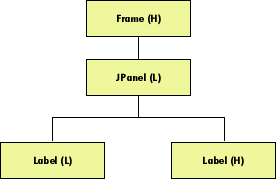
For the sake of the example, let's assume that the two labels overlap, and that the z-order value of the Swing label places it "on top" of the AWT label. But it still looks like this:
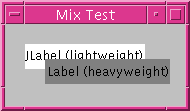
The Swing label will never appear to be on top of the AWT label because the Swing label is rendering its contents in the native window of the frame (its first heavyweight ancestor), while the AWT label is rendering its contents in its own native window, which is actually a child of the frame's native window.
If the Swing and AWT components do not overlap, then in general there should be no problems mixing them within the same container.
Guideline No. 1
Do not mix lightweight (Swing) and heavyweight (AWT) components within a container where the lightweight component is expected to overlap the heavyweight one.
The lightweight/heavyweight z-order limitation causes some problems in specific areas of Swing. When developers run into these problems, they often don't realize the cause, and immediately conclude that there's a bug in Swing. The three most common z-order-related problems have to do with Swing's JScrollPane and JInternalFrame classes, and its popup components.
Both the JScrollPane class and its viewport -- which clips its scrollable child -- are lightweight components. Consequently, heavyweight components cannot be handled properly when they are placed inside a JScrollPane's viewport. This is a window created by a little program that places both a Swing JButton and an AWT Button within a JScrollPane:
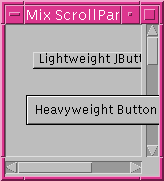
As you can see, the lightweight viewport cannot -- and does not -- clip the heavyweight AWT button properly.
Guideline No. 2
Do not place heavyweight (AWT) components inside a JScrollPane. If you need to scroll areas containing heavyweight components, use AWT's ScrollPane instead.
Swing's JInternalFrame component
Swing's JInternalFrame is a lightweight component. Typically, InternalFrame components are placed inside a JDesktopPane component, where the user can move the InternalFrames around in such a way that they can potentially overlap. Therefore, if heavyweight components are placed inside an InternalFrame, and that InternalFrame is overlapped by another InternalFrame, the first frame's heavyweight children will always be on top, potentially obscuring the other InternalFrame. This is a screen shot that illustrates this problem:
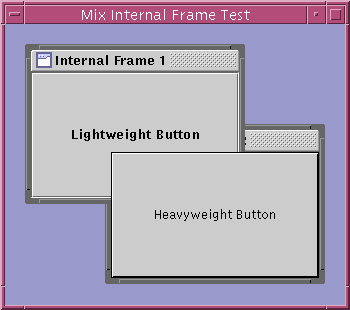
The Swing team is considering adding the option of creating InternalFrames as heavyweight containers in a future Swing release to alleviate this problem. However, until then, adhere to the following guideline:
Guideline No. 3
Do not place heavyweight (AWT) components inside a JInternalFrame.
Swing popup components
Swing provides a number of components that create popup windows (windows that dynamically appear when the user clicks on the component). These popup components are JPopupMenu, JComboBox, and JMenuBar.
Swing attempts to maximize popup performance by dynamically choosing the most efficient container to display a popup just prior to showing the popup. The types of popups created are:
The rules that Swing uses to determine which popup to use are:
Another benefit of displaying lightweight and medium-weight popups is that within a browser environment, this strategy avoids the display of the "Warning Applet" banner in the menus.
By default, the lightWeightPopupEnabled property is set to true for all popup components. Therefore, if you place a Swing popup component in a container that also contains an AWT heavyweight control, then it's possible that the popup will be obscured by the heavyweight control (if conditions are such that a "lightweight popup" is used). For example, if you place a JComboBox and an AWT Button in a panel, you might see the following result when you activate the combo box:
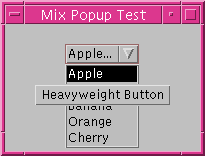
Notice that the combo box's popup window is painted behind the AWT button!
Fortunately, programs can easily disable the LightWeight Popup feature by setting the lightWeightPopupEnabled property to false. There are two ways to perform this operation. First, you can change the default value for this property globally for a program using the following static method on JPopupMenu:
public static void
setDefaultLightWeightPopupEnabled(boolean)
Once this method is invoked with a value of false, all popup components subsequently instantiated will initialize their lightWeightPopupEnabled property to false.
Second, a program can control this for individual popup instances by using instance methods provided by JPopupMenu and JComboBox:
public void setLightWeightPopupEnabled(boolean)
Setting this property on individual popup instances will override the default value controlled by the static JPopupMenu method.
The following sample program mixes a Swing MenuBar (a lightweight component) with an AWT Button (A heavyweight component). The "Lite" menu-bar menu defaults to enable lightweight popups while the "Heavy" menu uses the setDefaultLightWeightPopupEnabled() method to ensure the menu is never lightweight.
import
java.awt.*;
import com.sun.java.swing.*;
public class
MixPopupTest extends JFrame {
public
MixPopupTest() {
super("Mix
Popup Test");
JMenuBar
menubar = new JMenuBar();
setJMenuBar(menubar);
//
Create lightweight-enabled
menu
JMenu menu = new
JMenu("Lite Menu");
menu.add("Salad");
menu.add("Fruit Plate");
menu.add("Water");
menubar.add(menu);
// Create
lightweight-disabled menu
JPopupMenu.
setDefaultLightWeightPopupEnabled
(false);
menu = new
JMenu("Heavy Menu");
menu.add("Filet Mignon");
menu.add("Gravy");
menu.add("Banana Split");
menubar.add(menu);
// Create
Heavyweight AWT Button
Button heavy = new
Button
(" Heavyweight Button
");
// Add heavy button to
box
Box box =
Box.createVerticalBox();
box.add(Box.createVerticalStrut(20));
box.add(heavy);
box.add(Box.createVerticalStrut(20));
getContentPane().add("Center",
box);
pack();
}
public static
void main(String[] args)
{
MixPopupTest t = new
MixPopupTest();
t.show();
}
}
 The Solaris version of AWT currently has a bug that
can cause MediumWeight popups to not be displayed
properly.
The Solaris version of AWT currently has a bug that
can cause MediumWeight popups to not be displayed
properly.
See the Solaris MediumWeight popup bug overview for a more complete description of the problem and the workaround you can use to fix it.
Guideline No. 4
If you place Swing popup components in a window containing heavyweight components and it's possible that the popup windows will intersect a heavyweight, then invoke
JPopupMenu.setDefaultLightWeightPopupEnabled
(false)
before the popup components are instantiated.
If you understand the limitations of mixing Swing and AWT components, it is generally possible to build Java programs which use both in harmony. However, because there are significant advantages to using lightweight components, we recommend using lightweights (and Swing!) wherever possible and only using heavyweight components where a lightweight version either isn't yet available or doesn't meet your program's needs.